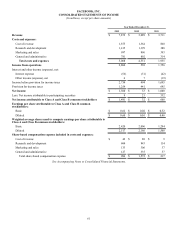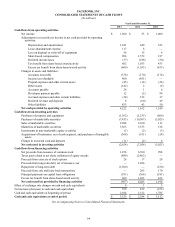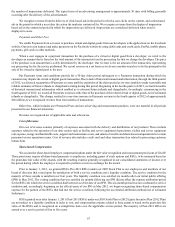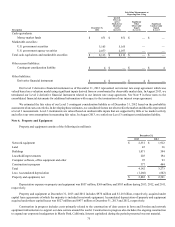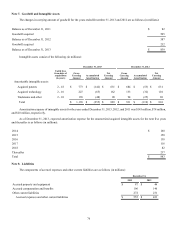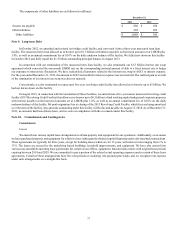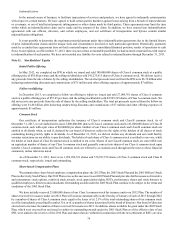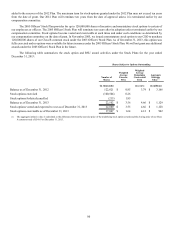Facebook 2013 Annual Report Download - page 72
Download and view the complete annual report
Please find page 72 of the 2013 Facebook annual report below. You can navigate through the pages in the report by either clicking on the pages listed below, or by using the keyword search tool below to find specific information within the annual report.
70
Loss Contingencies
We are involved in various lawsuits, claims, investigations and proceedings that arise in the ordinary course of business. We record
a liability when we believe that it is both probable that a loss has been incurred and the amount can be reasonably estimated. Significant
judgment is required to determine both probability and the estimated amount. We review these provisions at least quarterly and adjust
these provisions accordingly to reflect the impact of negotiations, settlements, rulings, advice of legal counsel, and updated information.
Business Combinations
We allocate the fair value of purchase consideration to the tangible assets acquired, liabilities assumed and intangible assets acquired
based on their estimated fair values. The excess of the fair value of purchase consideration over the fair values of these identifiable assets
and liabilities is recorded as goodwill. Such valuations require management to make significant estimates and assumptions, especially
with respect to intangible assets. During the measurement period, which is one year from the acquisition date, we may record adjustments
to the assets acquired and liabilities assumed, with the corresponding offset to goodwill. Upon the conclusion of the measurement period,
any subsequent adjustments are recorded to earnings.
Long-Lived Assets, Including Goodwill and Other Acquired Intangible Assets
We evaluate the recoverability of property and equipment and amortizable intangible assets for possible impairment whenever
events or circumstances indicate that the carrying amount of such assets may not be recoverable. Recoverability of these assets is measured
by a comparison of the carrying amounts to the future undiscounted cash flows the assets are expected to generate. If such review indicates
that the carrying amount of property and equipment and intangible assets is not recoverable, the carrying amount of such assets is reduced
to fair value. We have not recorded any significant impairment charge during the years presented.
We review goodwill for impairment at least annually or more frequently if events or changes in circumstances indicate that the
carrying value of goodwill may not be recoverable. We have elected to first assess the qualitative factors to determine whether it is more
likely than not that the fair value of our single reporting operating unit is less than its carrying amount as a basis for determining whether
it is necessary to perform the two-step goodwill impairment under Accounting Standards Update (ASU) No. 2011-08, Goodwill and
Other (Topic 350): Testing Goodwill for Impairment, issued by the Financial Accounting Standards Board (FASB). If we determine that
it is more likely than not that its fair value is less than its carrying amount, then the two-step goodwill impairment test is performed. The
first step, identifying a potential impairment, compares the fair value of the reporting unit with its carrying amount. If the carrying amount
exceeds its fair value, the second step would need to be performed; otherwise, no further step is required. The second step, measuring
the impairment loss, compares the implied fair value of the goodwill with the carrying amount of the goodwill. Any excess of the goodwill
carrying amount over the applied fair value is recognized as an impairment loss, and the carrying value of goodwill is written down to
fair value. As of December 31, 2013, no impairment of goodwill has been identified.
Acquired amortizable intangible assets, which are included in goodwill and intangible assets, net, are amortized on a straight-line
basis over the estimated useful lives of the assets. The estimated remaining useful lives for intangible assets range from less than one
year to 16 years.
In addition to the recoverability assessment, we routinely review the remaining estimated useful lives of property and equipment
and amortizable intangible assets. If we reduce the estimated useful life assumption for any asset, the remaining unamortized balance
would be amortized or depreciated over the revised estimated useful life.
Deferred Revenue and Deposits
Deferred revenue consists of billings in advance of revenue recognition. Deposits relate to unused virtual currency held by our
users. Once this virtual currency is utilized by a user, approximately 70% of this amount would then be payable to the developer and the
balance would be recognized as revenue.
Deferred revenue and deposits consists of the following (in millions):
December 31,
2013 2012
Deferred revenue $ 13 $ 8
Deposits 25 22
Total deferred revenue and deposits $ 38 $ 30



